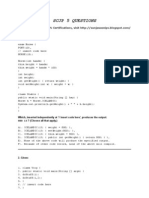Python Notes 1
Uploaded by
qwertyemperor1234567890Python Notes 1
Uploaded by
qwertyemperor1234567890Python Notes 1
What makes a computor
work?------------------------------------------------------------------------------
-----------------------------------------------------------------------------------
A program makes a computer usable, computers cannot work without a program.
Without a program, a computer, even the most powerful one, is nothing more than an
object.
Computers are able to perform very complex tasks, but this ability is not innate.
It can execute only extremely simple operations.
Contemporary computers can only evaluate the results of very fundamental
operations.
Such as adding or dividing, but they can do it very fast, and can repeat these
actions virtually any number of times.
What is a programming
language?--------------------------------------------------------------------------
-----------------------------------------------------------------------------------
A language is a means (and a tool) for expressing and recording thoughts.
Another language you use each day is your mother tongue, which you use to manifest
your will and to ponder reality.
Computers have their own language, too, called machine language, which is very
rudimentary.
All current machine languages are developed by humans.
A computer, even the most technically sophisticated, is devoid of even a trace of
intelligence it responds only to a predetermined set of known commands.
The commands it recognizes are very simple.
A complete set of known commands is called an instruction list, sometimes
abbreviated to IL.
What makes a
language?--------------------------------------------------------------------------
-----------------------------------------------------------------------------------
---------
We can say that each language (machine or natural), consists of the following
elements.
A alpabet - is a set of symbols used to build words of a certain language.
A lexis - is a dictionary a set of words the language offers its users.
A syntax - is a set of rules formal or informal, used to determine if a certain
string of words forms a valid sentence.
Sematicss - is a set of rules determining if a certain phrase makes sense.
Machine Language Vs High Level
Language?--------------------------------------------------------------------------
--------------------------------------------------------------------------
The IL is, in fact, the alphabet of a machine language.
This is the simplest and most primary set of symbols we can use to give commands to
a computer.
It's the computer's mother tongue, unfortunately this mother tongue is a far cry
from a human mother tongue.
We both (computers and humans) need something else, a common language for computers
and humans, or a bridge between the two different worlds.
We need a language in which humans can write their programs.
A language that computers may use to execute the programs.
A language that is far more complex than machine language and yet far simpler than
natural language.
Such languages are often called high-level programming languages.
They are at least somewhat similar to natural ones in that they use symbols, words
and conventions readable to humans.
These languages enable humans to express commands to computers that are much more
complex than those offered by ILs.
A program written in a high-level programming language is called a source code.
Similarly, the file containing the source code is called the source file.
Interpretation Vs
Compilation?-----------------------------------------------------------------------
-----------------------------------------------------------------------------------
----
Computer programming is the act of composing the selected programming language's
elements in the order that will cause the desired effect.
The effect could be different in every specific case and it's up to the
programmer's imagination, knowledge and experience.
The script has to make sense alphabetically, lexically, syntactically and
sematically.
Unfortunately, a programmer can also make mistakes with each of the above four
senses.
Each of them can cause the program to become completely useless.
Let's assume that you've successfully written a program.
How do we persuade the computer to execute it; You have to render your program into
machine language.
There are two different ways of transforming a program from a high-level
programming language into machine language.
Compilation – the source program is translated once (however, this act must be
repeated each time you modify the source code) by getting a file containing the
machine code.
Now you can distribute the file worldwide; the program that performs this
translation is called a compiler or translator.
Interpretation – you (or any user of the code) can translate the source program
each time it has to be run.
The program performing this kind of transformation is called an interpreter, as it
interprets the code every time it is intended to be executed.
It also means that you cannot just distribute the source code as-is, because the
end-user also needs the interpreter to execute it.
Due to some very fundamental reasons, a particular high-level programming language
is designed to fall into one of these two categories.
There are very few languages that can be both compiled and interpreted.
What does the interpreter
do?--------------------------------------------------------------------------------
-------------------------------------------------------------------------------
Let's assume once more that you have written a program.
Now, it exists as a computer file: a computer program is actually a piece of text,
so the source code is usually placed in text files.
Note: it has to be pure text, without any decorations like different fonts, colors,
embedded images or other media.
Now you have to invoke the interpreter and let it read your source file.
The interpreter reads the source code in a way that is common in Western culture:
from top to bottom and from left to right.
First of all, the interpreter checks if all subsequent lines are correct (using the
four aspects covered earlier).
If the compiler finds an error, it finishes its work immediately.
The only result in this case is an error message.
The interpreter will inform you where the error is located and what caused it.
However, these messages may be misleading, as the interpreter isn't able to follow
your exact intentions, and may detect errors at some distance from their real
causes.
If the line looks good, the interpreter tries to execute it.
Each line is usually executed separately, so the trio "read-check-execute" can be
repeated many times, as some parts of the code may be executed more than once.
t is also possible that a significant part of the code may be executed successfully
before the interpreter finds an error.
This is normal behavior in this execution model.
Complation Vs Interpretation - Advatages and
Disadvatages?----------------------------------------------------------------------
------------------------------------------------------------
Compilation Advatages - the execution of the translated code is usually faster.
Only the user has to have the compiler and the end-user may use the code without
it.
The translated code is stored using machine language as it is very hard to
understand it, your own inventions and programming tricks are likely to remain your
secret.
Interpretation Advatages - you can run the code as soon as you complete it, there
are no additional phases of translation.
The code is stored using programming language, not machine language this means that
it can be run on computers using different machine languages.
Compilation Disadvatges - the compilation itself may be a very time-consuming
process you may not be able to run your code immediately after making an amendment.
You have to have as many compilers as hardware platforms you want your code to be
run on.
Interpretation Disadvatages - don't expect interpretation to ramp up your code to
high speed your code will share the computer's power with the interpreter, so it
can't be really fast.
Both you and the end user have to have the interpreter to run your code.
Python is an interpreted language.
This means that it inherits all the described advantages and disadvantages.
Of course, it adds some of its unique features to both sets.
If you want to program in Python, you'll need the Python interpreter.
You won't be able to run your code without it.
Fortunately, Python is free.
This is one of its most important advantages.
Languages designed to be utilized in the interpretation manner are often called
scripting languages, while the source programs encoded using them are called
scripts.
You might also like
- Programming Essentials in Python: Module 1No ratings yetProgramming Essentials in Python: Module 145 pages
- Compilation vs. Interpretation - Advantages and DisadvantagesNo ratings yetCompilation vs. Interpretation - Advantages and Disadvantages3 pages
- AANDC Preliminary Discontinution For AANDC v04.04.xx100% (1)AANDC Preliminary Discontinution For AANDC v04.04.xx9 pages
- What Makes A Language?: Certified Entry-Level Python Programmer (PCEP-30-02)No ratings yetWhat Makes A Language?: Certified Entry-Level Python Programmer (PCEP-30-02)26 pages
- Module 1 - Introduction to Python and Computer ProgrammingNo ratings yetModule 1 - Introduction to Python and Computer Programming11 pages
- 0.1 Programming Absolute Basics 0.1.1 How Does A Computer Program Work?No ratings yet0.1 Programming Absolute Basics 0.1.1 How Does A Computer Program Work?29 pages
- How Does A Computer Program Work?: Language Is The KeywordNo ratings yetHow Does A Computer Program Work?: Language Is The Keyword10 pages
- Compiler Vs Interpreter: Complete Difference Between Compiler and InterpreterNo ratings yetCompiler Vs Interpreter: Complete Difference Between Compiler and Interpreter4 pages
- Cisco Python: Welcome To Programming Essentials in Python - Part 1100% (2)Cisco Python: Welcome To Programming Essentials in Python - Part 131 pages
- COMPUTER PROGRAMMING FOR KIDS: An Easy Step-by-Step Guide For Young Programmers To Learn Coding Skills (2022 Crash Course for Newbies)From EverandCOMPUTER PROGRAMMING FOR KIDS: An Easy Step-by-Step Guide For Young Programmers To Learn Coding Skills (2022 Crash Course for Newbies)No ratings yet
- 4.2 High and Low Level Languages IGCSE CS.docxNo ratings yet4.2 High and Low Level Languages IGCSE CS.docx14 pages
- Lesson 3 - Computer Programming Languages and Language TranslatorsNo ratings yetLesson 3 - Computer Programming Languages and Language Translators6 pages
- Python Programming for Beginners: A guide to Python computer language, computer programming, and learning Python fast!From EverandPython Programming for Beginners: A guide to Python computer language, computer programming, and learning Python fast!5/5 (1)
- Unit-1 Introduction To Compilers: Goals of TranslationNo ratings yetUnit-1 Introduction To Compilers: Goals of Translation22 pages
- Literature and English Language SBA Portfolio M.S.No ratings yetLiterature and English Language SBA Portfolio M.S.13 pages
- Every Social Media That Was Created After The 2000sNo ratings yetEvery Social Media That Was Created After The 2000s10 pages
- Chemistry 7 Methods of Mixture SeparationNo ratings yetChemistry 7 Methods of Mixture Separation11 pages
- Filza User Manual - Aug 14, 2019 at 936 PMNo ratings yetFilza User Manual - Aug 14, 2019 at 936 PM1 page
- Program: B. Tech Course Code:BCSE3096 Course Name: Cloud Application DevelopmentNo ratings yetProgram: B. Tech Course Code:BCSE3096 Course Name: Cloud Application Development9 pages
- Web Programming Step by Step: Reset Buttons (6.2.7)No ratings yetWeb Programming Step by Step: Reset Buttons (6.2.7)11 pages
- Chapter 8 - C Program Managing Input and Output OperationsNo ratings yetChapter 8 - C Program Managing Input and Output Operations9 pages
- How To Add and Clear Items in A ListBox ControlNo ratings yetHow To Add and Clear Items in A ListBox Control7 pages































































































